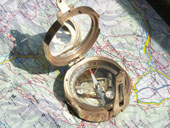
Purpose
To build a device that will trace the lines of the Earth's magnetic field.
Additional information
An inclinometer, also commonly known as a clinometer, tilt meter, and gradient meter, is a device used to measure angles of slope, inclination, and elevation in relation to gravitational pull. Measuring both incline (upward / positive slopes) and decline (downward / negative slopes), this device is used in a number of areas, such as astronomy, surveying, and engineering.
Sponsored Links
Required materials
- Small Styrofoam ball (available at any crafts store)
- Wire hanger
- Wire clippers
- Knitting needle
- Compass
- 2 glasses (tumblers) of equal size
- Protractor
- Wood block that is at least a couple inches larger than the protractor
- Strong bar magnet
- Tape
Estimated Experiment Time
About 30 minutes
Step-By-Step Procedure
- 1. Clip a straight piece of wire from the wire hanger. Do so by clipping the left-bottom of the hanger with the wire clippers and then doing the same on the right-bottom of the hanger. Discard the reaming hanger.
- 2. Push the hanger through the center of the Styrofoam ball. The ball should rest in the center of the wire, with equal lengths of wire exposed on each side. See Figure 1.
- 3. Carefully stick the needle through the Styrofoam ball at an angle that is perpendicular to the wire. The needle will need be placed slightly above-center or below-center so it's insertion does not get blocked by the hanger wire. See Figure 2.
- 4. Place the glasses (tumblers) on a flat surface a few inches apart. Place your compass assembly on top of the glasses so that the compass needle is resting on each glass. The Styrofoam ball and wire should be suspending in the air between the glasses. See Figure 3.
- 5. Adjust the glasses so that the hanger is pointing in the north-south position.
- 6. Now it's time to charge up the hanger with the magnet. Rub the northern pole end of the magnet several times on the north side of the hanger. The northern tip of the hanger will become polarized (charged) as a north-seeking compass needle.
- 7. Set the woodblock on a flat surface. Use tape to attach the protractor to the wood block in an upside down position, so that the flat edge of the protractor rests against the top of the wood block.
- 9. Move the wood block, with the curved end of the protractor facing down, between the glasses so that it is located beside the Styrofoam ball.
- 10. Wait and allow the hanger (compass needle) to settle into position. Observe the angle that it rests at.
Note
The configuration of the Inclinometer could be tricky the first time. Don't rush through the project! Follow the steps carefully and take your time. If your first Inclinometer doesn't quite work out, try again until you get it right.
Figures & Illustrations
Observation
In which direction would your needle point if you were to take your inclinometer to the North Pole? How about the South Pole? Why is it that a north seeking needle can point to the North Pole when like poles repel and opposite poles attract?
Result
The earth's magnetic force causes the magnetized needle to dip between the glasses at a 45 degree angle. This phenomenon mimics the function of an Inclinometer. If you were to take your compass to the North Pole and charge it, the needle would point upward.
Sponsored Links
Take a moment to visit our table of Periodic Elements page where you can get an in-depth view of all the elements,
complete with the industry first side-by-side element comparisons!